
The helicity, or handedness, of neutrinos has only been observed in two states, left-handed neutrinos and right-handed antineutrinos. Whether these are really the only two neutrino handedness states depends on whether neutrinos are their own antiparticles. Credit: Lawrence Berkeley National Laboratory
Searching for the answer to the question of whether neutrinos are their own antiparticles, the MAJORANA Collaboration has an underground experiment that could rewrite the Standard Mode.
In a cavern almost a mile underground in the Black Hills, an experiment called the MAJORANA DEMONSTRATOR, 40 kilograms of pure germanium crystals enclosed in deep-freeze cryostat modules, will soon set out to answer one of the most persistent and momentous questions in physics: are neutrinos their own antiparticles? If the answer is yes, it will require rewriting the Standard Model of Particles and Interactions, our basic understanding of the physical world.
“The best way to learn whether neutrinos are their own antiparticles would be to observe a certain kind of radioactive decay, called neutrinoless double-beta decay. It has never been detected conclusively, and if it occurs at all, it’s exceedingly rare,” says Alan Poon of the Nuclear Science Division at the U.S. Department of Energy’s Lawrence Berkeley National Laboratory (Berkeley Lab).

Carbon 14 decays to nitrogen 14 by emitting an electron and an antineutrino, while changing one of its neutrons to a proton and transforming the nucleus one place higher in the periodic table – a common kind of single beta decay. In a rare double-beta decay, for example when germanium 76 changes to selenium 76, two neutrons change to protons while emitting two electrons and two antineutrinos, transforming the nucleus two places higher in the periodic table. Credit: Lawrence Berkeley National Laboratory
Poon is the current executive-committee chair of the MAJORANA Collaboration, which is comprised of more than 100 researchers from 19 institutions in the United States, Canada, Russia, and Japan, and whose efforts are focused on the experiment now under construction at the Davis Campus of the Sanford Underground Research Facility (SURF) in Lead, South Dakota.
Beta decay, single and double
Ordinary beta decay is a common kind of radioactivity: an atomic nucleus changes into a different kind of element, a neighbor on the periodic table with lower mass, by emitting a beta particle – an electron or positron – plus a neutrino or an antineutrino. For example, carbon-14 transforms to nitrogen-14 when one of its neutrons turns into a proton, emitting an electron and an antineutrino. It was beta decay that led to the proposal that there must be a particle like the neutrino, since an electron alone could not account for all the energy lost in the decay.
“Double-beta decay is also possible and has been observed in a dozen different isotopes since 1986,” says Poon. “But it happens at a really low rate, and not too many nuclei can do it.”
The only conclusive double-beta decays seen so far involve two neutrons that change into two protons while emitting two electrons and two antineutrinos. It’s an uncommon situation, in which single beta decay is blocked because the decaying isotope’s immediate neighbor has a nucleus that’s too heavy, but the nucleus of the neighbor two places away on the periodic table does have lower mass – even though its atomic number is two places higher. Getting there requires double-beta decay.
One of the relatively few nuclei that can transform by double-beta decay is germanium-76 (76Ge), an isotope that accounts for less than eight percent of naturally occurring germanium. Germanium-76 can’t change to its neighbor, arsenic-76, but it can change to selenium-76, two places higher on the periodic table.
Many reference works refer to germanium-76 as stable, but double-beta decays of 76Ge have been observed since the 1990s, and its half-life has recently been estimated at 1.3 x 1021 years, or roughly one and a third sextillion years. That’s 100 trillion times the age of the universe. Not quite stable.
How do you detect such a rare event? If you watch a single germanium-76 atom for one and a third sextillion years, the chances are 50-50 you’ll see it decay. On the other hand, if you watch one and a third sextillion germanium-76 atoms for just one year, the chances are 50-50 that you’ll catch at least one of them decaying.
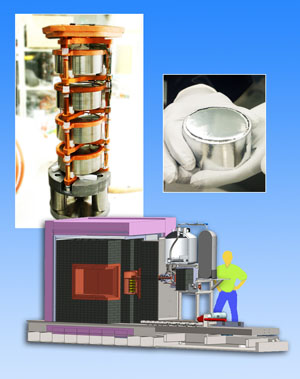
Individual detectors made of pure germanium are assembled in strings and remotely loaded into the lead- and copper-shielded MAJORANA DEMONSTRATOR. Credit: Lawrence Berkeley National Laboratory
In essence, that’s what MAJORANA proposes to do. The full MAJORANA concept calls for a metric ton or so of germanium diode detectors, enriched to 86 percent 76Ge. Over the course of a year, a detector that size has a good chance of catching double-beta decays, although most will be accompanied by a pair of antineutrinos.
Searching for an absence of neutrinos
Identifying neutrinoless double-beta decays depends crucially on getting rid of the background from cosmic rays and natural radioactivity in the surroundings. That’s the purpose of the MAJORANA DEMONSTRATOR: to show that achieving a low enough background is indeed possible. A mile of rock overhead is an effective shield against most cosmic ray debris, but radioactivity from the environment, including from impurities in the experiment’s own components, is harder to avoid.
Jason Detwiler of the Nuclear Science Division, who has been involved with the MAJORANA project since 2005, says, “We’re spending a lot of time modeling every one of the DEMONSTRATOR’s thousands of individual parts, to make sure we can achieve the lowest backgrounds of any experiment of this kind ever – a hundred times lower.”
The MAJORANA DEMONSTRATOR will be shielded with multiple layers of copper and lead against radioactive elements in the surrounding rock, and the detector will be built from ultrapure materials. Copper components are being formed underground in special facilities at SURF, to remove natural radioactivity and prevent contamination from cosmic rays.
Equally important is the detector’s ability to distinguish the background from double-beta decays inside the detector itself. Pure germanium is ideal for this purpose, both as a source of double-beta decays and, says Detwiler, as a detector that “can register the signal of nuclear decays cleanly, beautifully, and in high resolution.”
Nuclear decays and other events create charge carriers that drift toward the collecting electrode on the surface of the germanium diode. The way the carriers drift – their “pulse shape” – will clearly distinguish background events from a neutrinoless double-beta decay.
“Berkeley Lab developed germanium detectors decades ago, so we have a history of strength and expertise in design and manufacture,” Detwiler says. “We’re working with a U.S.-based commercial vendor to turn germanium-76, enriched at an isotope separation facility in Russia, into working detectors. We’ll mount them with low-noise electronics developed here.”
The first pure germanium in the DEMONSTRATOR will be a natural mix of isotopes, setting a baseline for response to background events. Eventually 30 kilograms (66 pounds) of the detector’s 40-kilogram (88-pound) total will be enriched to 86-percent germanium-76, narrowing the chance that background signals could compete with the discovery of an actual neutrinoless double-beta decay event.
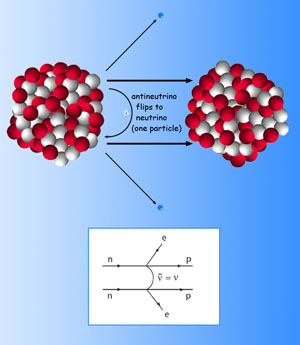
In neutrinoless double-beta decay, a single particle would be emitted as one neutron changes to a proton. This right-handed antineutrino would be absorbed as a left-handed neutrino by a second neutron, causing it too to change to a proton. Two electrons account for the total difference in energy between the nuclei. Credit: Lawrence Berkeley National Laboratory
Such an event would be easy to identify, because the energy of its two electrons would add to precisely 2.039 million electron volts (2.039 MeV), and none would be shared with antineutrinos. With a low enough background, MAJORANA will be able to easily separate the sharp spike of a 2.039 MeV two-electron event from a broad smear of energies shared among four different particles.
Rewriting the Standard Model
Mass is essential to oscillation among the three neutrino flavors, but no one knows the precise mass of any of the flavors or why it’s so small. Neutrinoless double-beta decay offers a unique window on that question. If MAJORANA can go beyond showing that neutrinoless double-beta decay exists to showing how often it occurs, it may be able to establish the mass scale of neutrinos directly.
The key is their handedness, or helicity (which refers to how their linear momentum and quantum spin are aligned). If neutrinos and antineutrinos are two distinct particles, each could be either right-handed or left-handed, for a total of four quantum states. If neutrinos and antineutrinos are just one particle, however, it has only two states of handedness. In fact only two states, left-handed neutrinos and right-handed antineutrinos, have ever been observed.
A diagram of neutrinoless double-beta decay shows a right-handed antineutrino emitted when a neutron decays (also emitting an electron). The antineutrino flips its handedness and is absorbed by a second neutron, which also decays (and emits a second electron). Only a single antiparticle/particle is involved. How fast it can flip its handedness depends on its mass: the more massive, the easier the flip, and the more often this kind of decay will occur.
But there’s a catch, says Poon. “The fascinating thing about neutrinoless double-beta decay is that it would violate one of the basic principles of the Standard Model, in which all interactions supposedly conserve lepton number. Electrons and neutrinos are both leptons, so if an interaction produces two electrons, that’s a plus two. In the usual kind of double–beta decay, two antineutrinos are also emitted – antiparticles with minus lepton numbers, which is a minus two. Lepton number is conserved at zero.” Not so with neutrinoless double-beta decay, however, which raises the lepton number from zero to two.
“The Standard Model leaves many outstanding questions, and we know it needs revision,” Poon says, “but we cannot write a new theory until we know if neutrinos are their own antiparticles, or how we’re going to accommodate the loss of lepton number conservation if they are, and a number of other questions, including neutrino mass.”
In the race to answer these questions, the MAJORANA Collaboration is competing with another important germanium experiment, the GERDA experiment at the underground Gran Sasso National Laboratory in Italy. But it’s a competition with a twist:
“GERDA has a different shielding concept, using liquid argon and water, and between us we’ll find out which has the lower background,” says Poon. “We may join forces to build the final one-ton detector.”
Germanium-76 is not the only element that can undergo double-beta decay. Other detectors use isotopes of tellurium, xenon, neodymium, or other elements. Poon says, “It’s important to establish that any instance of neutrinoless double-beta decay really reflects the property of the neutrino. If the process is seen in more than one element, that’s very strong evidence that the neutrino is indeed its own antiparticle.”




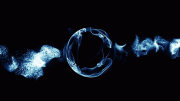
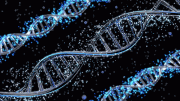
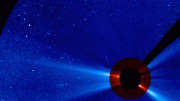


No mention of SuperNEMO. Where does it fit in?
…”The helicity, or handedness, of neutrinos has only been observed in two states, left-handed neutrinos and right-handed antineutrinos. Whether these are really the only two neutrino handedness states depends on whether neutrinos are their own antiparticles.”
******************
* Why? *
******************